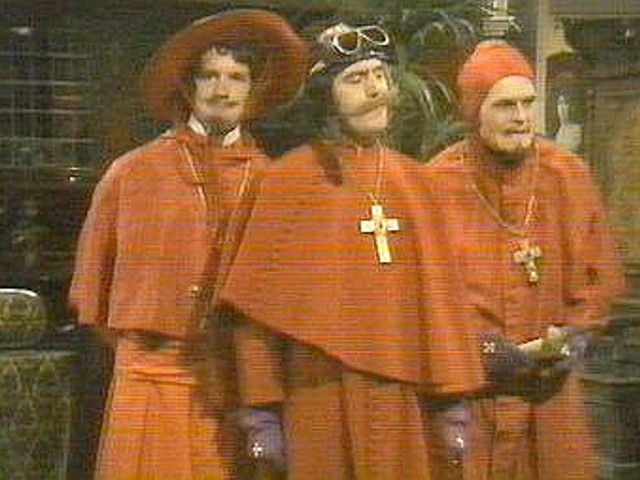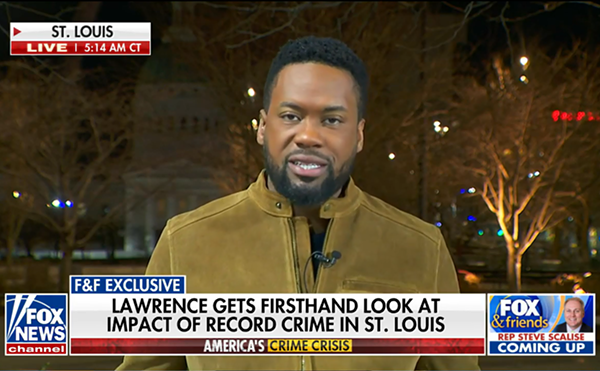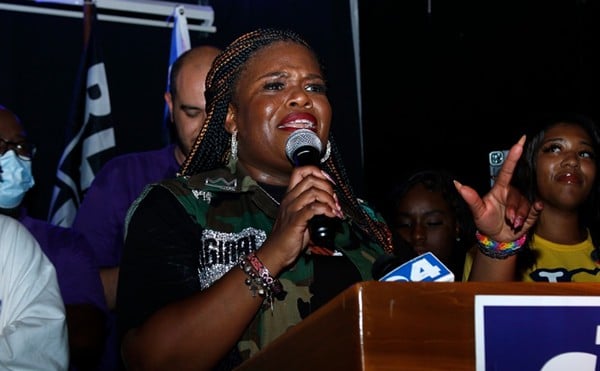Stepping from the quiet streets of Bonne Terre into Earl Mullins' space museum is like bringing one's eye to a telescope and being struck dizzy with stars. A rocket engine, two feet of sleek metal tubes and chambers, sits on a pedestal near the front door. It's the real deal, an LR-64 that delivers 1,000 pounds of thrust. To the right of it reclines a wooden model of the F-86 Saber jet built by Mercury astronaut Virgil "Gus" Grissom, not far from the life-size statue of a space traveler's puffy white suit.
In this old lead-mining town an hour's drive south of St. Louis, Mullins has created this array of rockets, ray guns and fire-proof beta cloth. A total 657 items, nearly all culled from his personal collection, fill a series of miniature exhibits. The tour begins with a display of toy space guns, including a 1938 Buck Rogers Atomic Pistol, before moving on to items depicting Russia and America's feverish efforts to reach the heavens first. Mullins' prized gems include a Mercury flight-operations manual signed by Scott Carpenter, one of the original astronauts, and a medallion-size piece of the heat shield from the command module of Apollo 8, which orbited the moon on Christmas Eve in 1968.
With a wide grin creasing his round face, Mullins is eager to share. "We're just trying to introduce the populace to the excitement and necessity of space exploration," he says.
A 56-year-old manager at a plastics plant in Arnold, Mullins can't recall a weekend away from the space museum since he opened it to the public in October 2005. Now, with the help of volunteers, the lights are on Friday through Monday.
Most of the walk-in traffic Mullins sees comes from the nearby Bonne Terre Mine, which was the world's foremost producer of lead at the turn of the 20th century. The owners of West End Diving in Bridgeton purchased the mine in 1980 and turned the expansive cavern into a tourist attraction. Today it offers underground boat rides and scuba diving in a "billion-gallon lake."
On a Saturday afternoon last month, a couple from Hermann stops at the space museum, a small brick building that formerly housed the mine company's utility office, to pick up a brochure for a possible return visit with their kids. Mullins isn't about to let them go, though, without talking up future plans for the museum. "Hopefully, one of these days this will be free," he says by way of apology for the admission price: $5 for adults, $3 for kids.
Soon, Mullins adds, the exhibits will move next door to a facility twice as big, where he and his boosters hope to build a theater. "What we're going to try to do in the theater is hook up some Godzilla subwoofers, so when we show a movie, you're going to get that feeling of what it's like to be near a launch," he says.
The ambitious plans take the Hermann man by surprise. "You wouldn't expect it in the little town of Bonne Terre," he remarks.
"I can't tell you how many times I hear that," Mullins replies with the folksy accent that hints at his southern Illinois upbringing. "Why Bonne Terre? Well, that's where I live. Besides, a lot of people will never have a chance to see this stuff. They'll have to travel too far."
Mullins' visitor ogles a small-scale model of SpaceShipOne that won the $10 million Ansari X Prize in 2004, as he mentions that he'd like to someday take his son to Cape Canaveral to witness a shuttle launch. Hearing this, Mullins enthuses, "Let me show you something real quick, kind of the next best thing to a launch."
He disappears behind the partition wall and heads into the main gallery. He returns hefting a 30-pound bolt. "It's one of eight bolts that hold the shuttle to the pad before it takes off," he explains. "They're made out of Inconel; that has a lot of nickel in it. They cost about $3,000 apiece."
The revelation sparks a long show-and-tell about the bolt. Having quizzed an engineer about what would happen if the nuts failed to come loose, Mullins relays that they're no match for the rocket power behind the shuttle. "Six and a half million pounds of thrust," he concludes in an admiring tone.
Mullins is fired up about his mission. "I really want to encourage people's interest in this. Space exploration is very important. It's vital right now." Taking his inspiration from the era led by John F. Kennedy's challenge to land a man on the moon before the end of 1960s, Mullins sees no limit to what he can accomplish with his homegrown museum.
"I want to create a nation of dreamers again. We were dreamers when we went to the moon."
On the morning of May 5, 1961, a nation held its collective breath as Alan Shepard prepared to be hurled into space atop a Redstone rocket. Mullins still remembers it all so vividly, how he and his fellow classmates in Vienna, Illinois, were taken to the school gym to witness on black-and-white TV the first American to travel into space.
"The town I lived in was 1,100 people. This was cutting edge! This was exciting! This was technology at its height! The thing I remember the most about it, everybody was quiet." Mullins says he could hear every word of the broadcast from Cape Canaveral, relaying the details of Shepard's fourteen-minute ride aboard Freedom 7. A nine-year-old science-fiction junkie, Earl was awestruck: "All of a sudden, it's becoming fact."
Growing up on a dairy farm, he'd found a 50-gallon steel drum that he pretended was a space capsule, from which he would fly his own "missions." He also collected spent rifle cartridges because they looked like rockets. "I just wanted to explore, man, I just wanted to be out there, in space. The moon wasn't even enough for me."
For the next two years, NASA launched a new Mercury flight every few months, all of which kept Mullins glued to the television. "My aunts and uncles and sisters and brothers — and everybody that knew me — would bring me newspapers and clippings," Mullins says. "Every mission was a milestone."
Even Echo 1, NASA's first communications satellite, captivated him. A chubby kid with a talent for building model rockets, he'd lay back in the grass at dusk and watch the giant metallic balloon, brighter than most stars, glide across the horizon. "It was just a point of light in the sky," says Mullins. "Everybody else would go in, and I'd wait for it to come around again. It was fascinating to me. I wanted to know how it worked."
Mullins aspired to a career in aerospace engineering, but by the time he graduated from high school in Farmington, he knew there wasn't enough money. The youngest of seven brothers and sisters, he and his mother were on their own after his parents' divorce. With higher education out of reach, Mullins took a two-year degree from Mineral Area College in St. Francois County.
Mullins grew disillusioned with NASA after the space shuttle Challenger exploded on the morning of January 28, 1986, killing its crew of seven just 73 seconds after liftoff. "I didn't want to believe it," says Mullins, who later pored over 450 pages of the damning congressional report on the accident. "It angered me. It was like those guys had been failed. It was a black eye. We had screwed up. Instead of being a technological giant, we got clobbered."
His daughter Monica, who was in elementary school at the time, remembers her dad's grief. "He was devastated," she says. "It was like he lost part of his family."
As one might expect, Mullins has watched virtually every space-related movie and television special released in the past twenty years. Among his favorites are Ron Howard's Apollo 13 and "From the Earth to the Moon," a Tom Hanks miniseries about the Apollo project. The museum sells copies of the movie October Sky, the true story of Homer Hickam, a coal miner's son-turned-rocketeer. But don't expect to find a copy of The Right Stuff.
Tom Wolfe's 1979 bestseller and the 1983 film adaptation focused on the macho fighter-pilot culture of this country's first astronauts. Mullins does not dispute that his heroes were hard-drinking, fast-driving womanizers. "These guys weren't choir boys," he says.
He does have one major objection, and that's the way Wolfe portrayed Gus Grissom, America's second man in space. It was Grissom's suborbital flight on July 21, 1961, that ended badly, with his capsule sinking in the Atlantic — and him nearly drowning — because the escape hatch blew open before a waiting helicopter could lift the bobbing pod from the water. The way NASA engineers saw it, Wolfe wrote, "Grissom had just screwed the pooch!"
"People were led to believe that he was a high-strung whiner that failed his mission because he lost his spacecraft," Mullins complains. "Nothing could be further from the truth."
Mullins has become friends with Grissom's younger brother Lowell. A 74-year-old McDonnell Douglas retiree who lives in O'Fallon, Missouri, Lowell Grissom has lent both moral support and credibility to the museum project. In fact, he invited Mullins to Cape Canaveral in January 2007 for a memorial service marking the 40th anniversary of the flash fire that killed Grissom, Ed White and Roger Chaffee. The Apollo 1 crew had been training for a moon mission in the command module atop a Saturn rocket when the control room heard the panicked cry, "Fire in the cockpit!"
Over the years, Earl Mullins has collected more than 400 model planes, learned to scuba dive and taught himself how to make knives. None of these hobbies, though, has proved anywhere near as fascinating as space.
The silver-bearded Mullins began in earnest to acquire space memorabilia fifteen years ago, and it wasn't long before his 100-year-old Bonne Terre home brimmed with the sacred objects. He still has the capsule-shaped pencil sharpener that he won at a carnival as a kid in Vienna, as well as the reel-to-reel tape of Walter Cronkite broadcasting the moon landing on July 20, 1969.
The size of the collection, half of which remains in storage, came as a surprise to his daughter Monica. "I never dreamed he had that much stuff tucked away," she says. "I said, 'What are you going to do with all this stuff?'"
Mullins' museum began with a desire for even more space mementos. He wanted high-profile artifacts, like the suits astronauts actually wore in space, but they were too expensive for most collectors. "I knew there were items out there available for loan," he says. "I thought, well, if I couldn't own them, it would be cool to just be around them."
Mullins has a humble, homespun personality, though when it comes to museum business, he's one relentless promoter. He'll hit up anyone he thinks can help him, from town leaders to Gregg Maryniak, director of the Saint Louis Science Center's James S. McDonnell Planetarium. Initially some people didn't take him seriously. Janet Barton, for one, an ex-city council member and the city manager's wife, admits that she thought a space museum in Bonne Terre sounded silly. "I did not even go to the grand opening," she says. Now she's one of its main boosters. "It's fun to be around Earl," she says. "It's overwhelming. The stuff he can remember — I'm talking detailed information."
Maryniak ignored Mullins' e-mails for a year before he consented to a visit. "I didn't know what to expect in a little, teeny-weeny former lead-mining town," Maryniak says. "I was blown away."
Painstaking in his work, Mullins has woven his opus from peripheral collectibles, aircraft models and Life magazine covers. The crackly sounds of an astronaut contacting mission control fill the gallery devoted to the early space programs.
At the end of the narrow room, a soft light illuminates a one-sixth scale model of the Mercury capsule, built by McDonnell Douglas engineers. Press a button at the base of the display and the wooden model rotates, offering a complete view of its internal components.
Mullins pulls on a pair of white cotton gloves before handling one of his favorite pieces in the collection. He unlocks a section of a long glass case and pulls out a yellowed letter, written in July 1959 by a little-known astronaut named Henry Gordon. "I don't know if you've seen The Right Stuff or not?" he asks. Gordon wrote the letter while undergoing a medical evaluation at the Lovelace Clinic in Albuquerque, same as the Mercury astronauts.
Gordon was among the pilots the Air Force recruited to fly a space plane called the X-20 Dyna-Soar, short for Dynamic Soarer. Gordon wrote that it was a "much more interesting and fascinating concept than the Mercury program." He could not foresee that the military would scrap the project in 1963, before finishing the first vehicle. "He wrote this letter to his mother," Mullins says. "The reason I like this is that it connects you with the people. It connects you with what's going on."
Mullins' most meaningful tie to Apollo 8, the flight he says "saved 1968," is a brown chunk of resin, which is mounted so that it rotates under a small glass dome, like a ballerina in a music box. "If you were to pick that up out of scrap bin somewhere, you'd probably throw it away," he says of the heat-shield sample. "A lot of these artifacts don't mean a thing until you know the story behind them."
Says Mullins of the Apollo 8 orbit in a year marred by the assassinations of Martin Luther King Jr. and Robert Kennedy: "Space gave us something to believe in when the world was burning down around us."
Earl Mullins is certain that space exploration could once again rally and inspire a country of "couch potatoes" and "people on Prozac." With the fervor leaking off him like vapor from rocket fuel, it's not surprising to learn that he was once a Southern Baptist pastor. "This is my ministry now," he says. "Everything I've done has led me to this point."
He's become as avid about perfecting the museum experience as he was in collecting. He wants more interactive exhibits for kids. He worries that the galleries are too brightly lit. The audio tour is an hour long, and he asks, fretting, "It's too much information, isn't it?"
He hopes Bonne Terre might one day have a museum that rivals the Kansas Cosmosphere and Space Center, which draws more than 200,000 people a year to the small city of Hutchinson.
The Cosmosphere began in 1962 as a makeshift planetarium in the poultry barn at the state fairgrounds. Today it's known for the deep-sea diving mission that it sponsored in 1999 to recover Grissom's Mercury capsule, the Liberty Bell 7. "It's a multimillion dollar facility," Mullins says. "If they can do it, we will."
A landscape scene that hangs in the museum's final exhibit depicts a man scaling to the top of a dusty red mesa. On the audio tour, which Mullins scripted himself, a rumbling voice laments, "Had we not become apathetic, this could have been a photograph, not a painting." Mullins has been waiting for 25 years to see humans reach Mars. "We should go because it's there," he says. "We should go and enjoy it."
NASA says it does intend to go to Mars. First, a project called Constellation is supposed to return humans to the barren lunar surface by 2020. Then the moon would serve as the low-gravity platform for launching the six-month journey to the Red Planet.
Roger Launius, curator of the National Air and Space Museum, says NASA has failed to inform, much less convince, Americans of the need for Constellation, whose mission President Bush announced in January 2004. "Just take a poll. Stand out on a street corner and ask people as they walk by, do they know we're going to the moon? And do they know why?" he asks. "A lot of people would say, 'Been there, done that.'"
NASA has set no firm date for the ultimate Mars feat. "Until then, it's kind of our jobs to keep people interested," says Louis Parker, the exhibits manager at the Johnson Space Center in Houston. Parker says he's trying to infuse his traveling shows with more information about Constellation. "We're trying to get the word out to folks that this is the new program on the horizon."
Anticipating a "very tedious, very expensive" road to Mars, Parker says, "We need more people like this Mr. Mullins. If it turns out this museum is his own private collection, well, great."
On July 12 the sixth man to walk on the moon, Edgar Mitchell, is planning to visit Bonne Terre, the town whose name is French for "good earth." Mullins is so wound up about Mitchell's coming that he sent a letter of invitation to President George Bush. Traveling from his home in Florida, the 77-year-old retired astronaut will see the museum and make a presentation in the municipal auditorium about the long-term sustainability of life on Earth.
"Space exploration and using resources from other planets are possibilities for us," says Mitchell by telephone during a recent interview. "We need to think beyond the confines of Earth."
Weeks before the big day, Mullins batted around ideas for the speech he planned to deliver at Mitchell's honorary dinner. He wonders, "Can middle America make a difference? Can some wild-eyed space geek make a difference?" Then he thought of all the great names in space exploration who hail from small towns: Gus Grissom from Mitchell, Indiana; Neil Armstrong from Wapakoneta, Ohio; Edwin Hubble from Marshfield, Missouri; Chuck Yeager from Myra, West Virginia.
"Do I have a right to put myself in the same category?" Earl Mullins asks. "Maybe not now, but someday."





